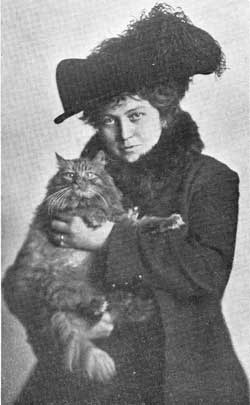 | ||









|
LONGHAIR/ANGORA/PERSIAN - ORANGE (RED/RED TABBY

Fanciers of 'Orange' or 'Red' cats are usually conscientious devotees to their color. And although they will also be admirers of other colors and/or patterns, for them, the red retains a special place in the heart and they are very often passionate about preserving it. Whether this is because they love the warm hot tones, or as is the case with the tabbies, the depth of color and contrast of a rich mahogany red upon a warm but lighter red ground, or for some other factor; each will have a reason they can relate to explain their relentless passion for this truly beautiful hue. For a few, it may be a genetic factor, like the noticeable predisposition for depth of eye color, or it will be something more mundane, such as their personalities, intelligence or either their affectionate natures, or, even on occasion, their diffidence! Regardless of the reason, the lovers of Reds are loyal to their cause and very often specialists in their variety. Most, but certainly not all of the earliest reds were agouti tabbies, and usually out of Tortoiseshells. Breeders very quickly noticed the paucity of Red females and although not aware in those days of the genetic link to the 'x' chromosome, soon realized that females of the variety were indeed rare, and to be prized when you were lucky enough to get one. As more breeders were aware that Red to Red, Red to Tortie, and Red to Cream helped to produce more of them, specialization increasingly became more the norm. As a result, over time, the 'Tortoiseshell', initially considered a 'sport' in color terms, became to be appreciated all the more, as a valuable addition to a breeding program. Among the earliest fanciers and breeders of Reds were Mrs. McLaren Morrison, and Lady Marcus Beresford. Among Mrs. Morrison's impressive list of cats can be found an imported red male named 'Barbarossa' (born in Sept.1891) who sired a string of 'oranges' for her, and her homebred red tabby 'King Dick', (born 1891), who was sired by her famous black, 'Neptune'. Lady Marcus Beresford, was the owner of the much-admired and notable solid red, 'Lifeguard' (born in 1895). A french-bred Red male, born at the Chateaux Fontainbleau, near Paris, in 1888, and appropriately named 'Napoleon', was exported to Mrs. Weed in the United States, where he was ultimately valued at an enormous $5,000. His progeny were highly sought after by a number of prominent local breeders and in some cases, syndicates were formed to secure them. With the new century, specialist breeders like Mrs. Vidal of 'Torrington' cattery fame, helped to popularize the color on both sides of the Atlantic and the American fanciers in particular appear to have especially seen the value of introducing Reds into a variety of breeding programs. It was in the U.S, that the type and popularity of Reds was firmly established, ultimately leading to the descriptive term 'peke-faced' red being liberally applied to describe a noticeably different head style in snub-faced red cats. The times were a-changing, and by the late 1940's, the head-style of Persians being bred on the American continent in generalwas gradually beginning to move in a different direction and pace from the head-style and type being bred in the United Kingdom. Over the next 30 years, this would become increasingly more apparent. Today, Reds the world over are among the very typiest of Persians, often sporting the deepest and most intense eye color. This is certainly not a new trait, and finding a red with intensely copper or even mahogany eye color is now very much the norm. In the 'modern' era we need only look at our pedigrees to note what the influence of a popular red stud male can achieve. Landmark cats that come to mind are those like 'GC Prim-Pet Yankee Doodle Dandy' bred by Evelyn Prather, or the many wonderful 'Bar-B' reds bred by Barbara K. Thal (Sumner), which have made an immense contribution. Just a handful of the very best include 'GC NW Corsica's Wouldn't You Know It', Best Kitten in 1979-80, bred by Greg and Diana West; 'GC NW Southpaw Sunburst', Best Cat in 1982-83, bred by Judy and Greg Brocato; 'GC NW Charoe's Rosetta of Comarro', Best Cat in 1984-85, bred by Marcia and Ron Collins; and the red tabby 'GC NW Q-T Cats Billy The Kid', Best Cat in 1994-95, bred by Marcia and Leon Samuels. But it is easy to forget, that this development has taken over 120 years. Reds continue to have the 'wow' factor when presented in a full flowing coat, and it is important that we never lose sight of the wonderful work done within this variety, by the exceptionally passionate breeders who have 'lighted the pathway' making it possible for us to enjoy what we, in this day and age, so very often take for granted. ORANGE (RED / RED TABBY) LONGHAIR HISTORIES(* = completed histories)
Registers associated with this article include The Incorporated Cat Fanciers Association of Great Britain (TICFAGB), National Cat Club (NCC), The Cat Club (CCR), Beresford Cat Club (BCC), Feline Federation Francaise (FFF), Siamese Cat Registry (SCR), US Register & Studbook for Cats (USR)including Supplement(USRS), The Studbook of the American Cat Association (ACA), and the Studbook & Register of the Cat Fanciers' Association (CFA).
|
|
Home | Cats | Gallery | Clubs | People | Artifacts | Articles | Updates | Contact Us ©The CFA Foundation, Inc and The Harrison Weir Collection
|
||